Introduction
The UGM-93A Trident I (C-4) was a three-stage U.S. submarine-launched ballistic missile with a range of about 4,000 nautical miles, double that previous generation Poseidon C-3. This allowed the C-4 to be the first missile that could reach Soviet targets from ports in the United States.
Designed in the late 1970s’ it was first named EXPO (Extended Range Poseidon) but was later renamed after the mythological trident of Neptune.
| Trident I C-4 SPECIFICATIONS | |
|---|---|
| Length: | 34 ft (10.39 m) |
| Diameter: | 6 ft. 2 in (1.88 m) |
| Weight: | 73,000 Ibs (33,112 kg) |
| Speed: | Supersonic; over 20,000 ft/sec |
| Range: | 4,000 n.miles (7,500 km) |
| Accuracy: | 1475 ft (450 m) C.E.P. |
| Propulsion: | 3-stage solid propellant |
| Guidance: | Inertial with stellar reference update |
| Warhead: | 8 MIRV W76 nuclear (100 KT) |
| Main contractor: | Lockheed Missile and Space Coorporation (now Lockheed Martin Space Systems, Missile and Space Operations, Sunnyvale, California) |
First deployed in 1979, the missile was carried by twelve out of 41 Polaris submarines and the first 8 Ohio-class submarines. However, it was considered an interim missile while new submarines of the Ohio class were built and the new and bigger Trident II D-5 was developed.
The last Trident C4 successful deterrence patrol was completed in 2003.
Description
Design
The UGM-96 Trident C-4 was designed to surpass the range of its predecessor, the Poseidon C-3 without altering its size or payload and fitting in the same tubes and submarines. Achieving this feat posed a challenge for Lockheed engineers.
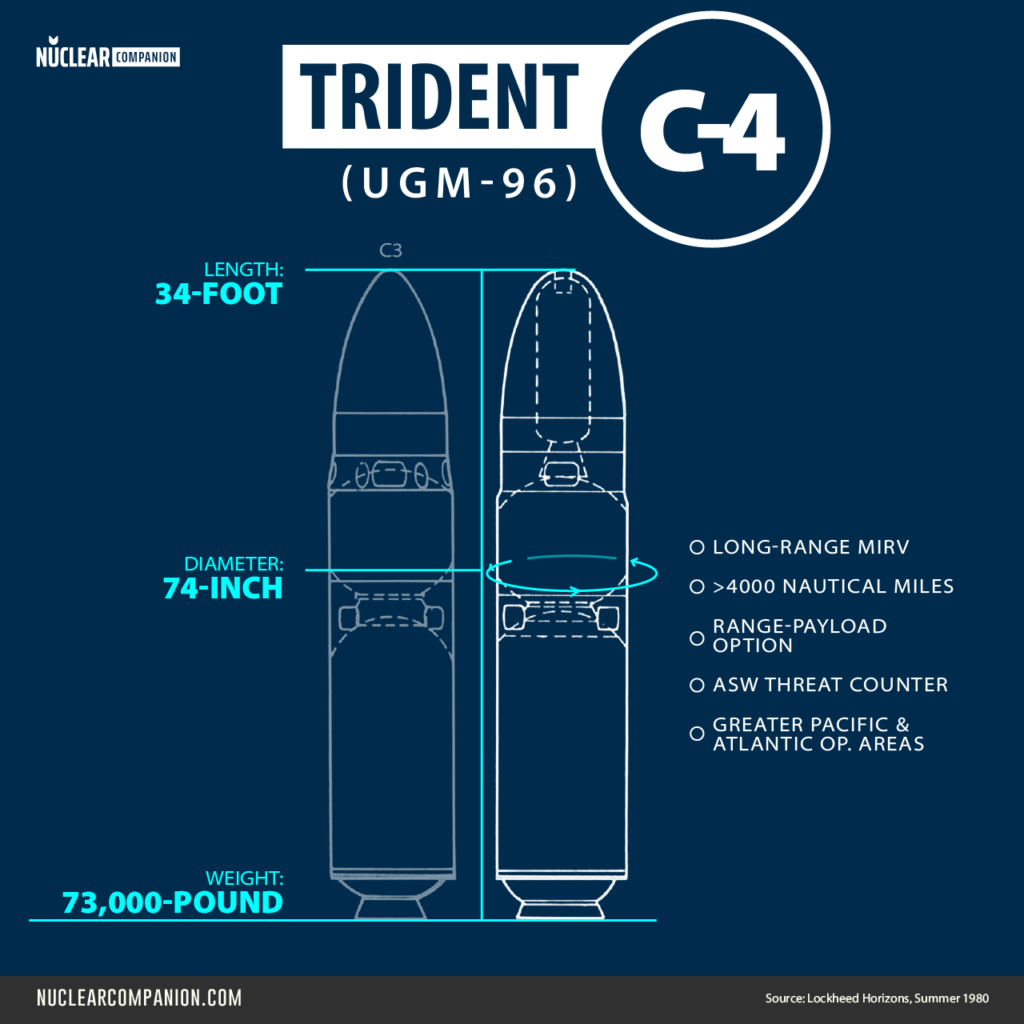
Their solution was multifaceted. First, they modified the payload section to introduce a third stage. Borrowing from the Patriot missile project, they selected a denser, more potent solid fuel that enhanced thrust per fuel volume. Although this fuel was heavier, a transition from the older fiberglass casings to lighter Kevlar variants offset the weight.
Further innovations came in the form of improved motor chamber materials and durable, lightweight nozzles.
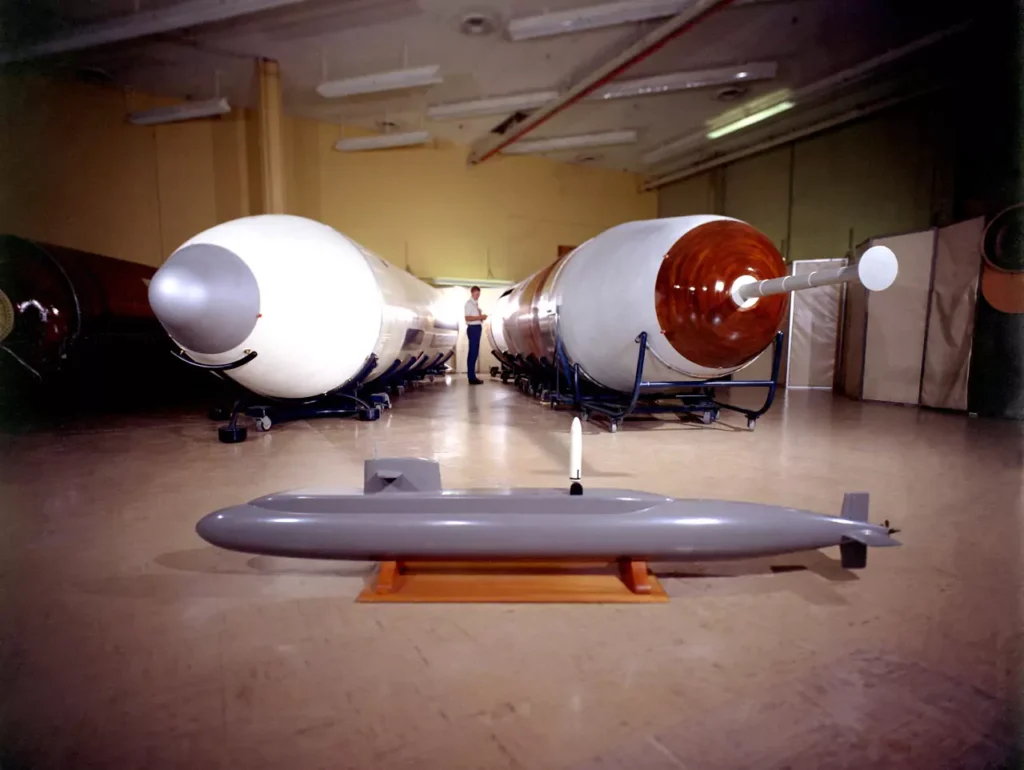
Another significant weight-saving measure was the replacement of aluminum components with a composite of graphite and epoxy, resulting in a missile that was approximately 40% lighter.
Electronic miniaturization and reconfiguration led to diminished package sizes, weights, and cabling, all of which allocated more volume for propulsion.
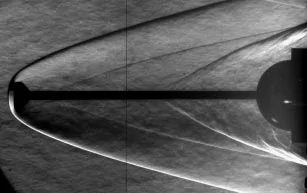
A groundbreaking feature of the missile was its ‘aerospike’. Deployed after launch, this extendable front spike reduced air drag, particularly during the early phases of flight. This innovation halved the drag on the missile’s distinct blunt nose fairing, which was designed to accommodate both the payload and the third-stage rocket. Consequently, the aerospike added an impressive 300 nautical miles to the missile’s range.
Guidance
The Trident I C-4 missile employed the Mk 5 guidance system which was notably smaller and lighter than Poseidon’s Mk 3 all-inertial system, offering additional room for propulsion. Even though it fundamentally resembled Poseidon’s, the Mk 5 added a stellar sensor.
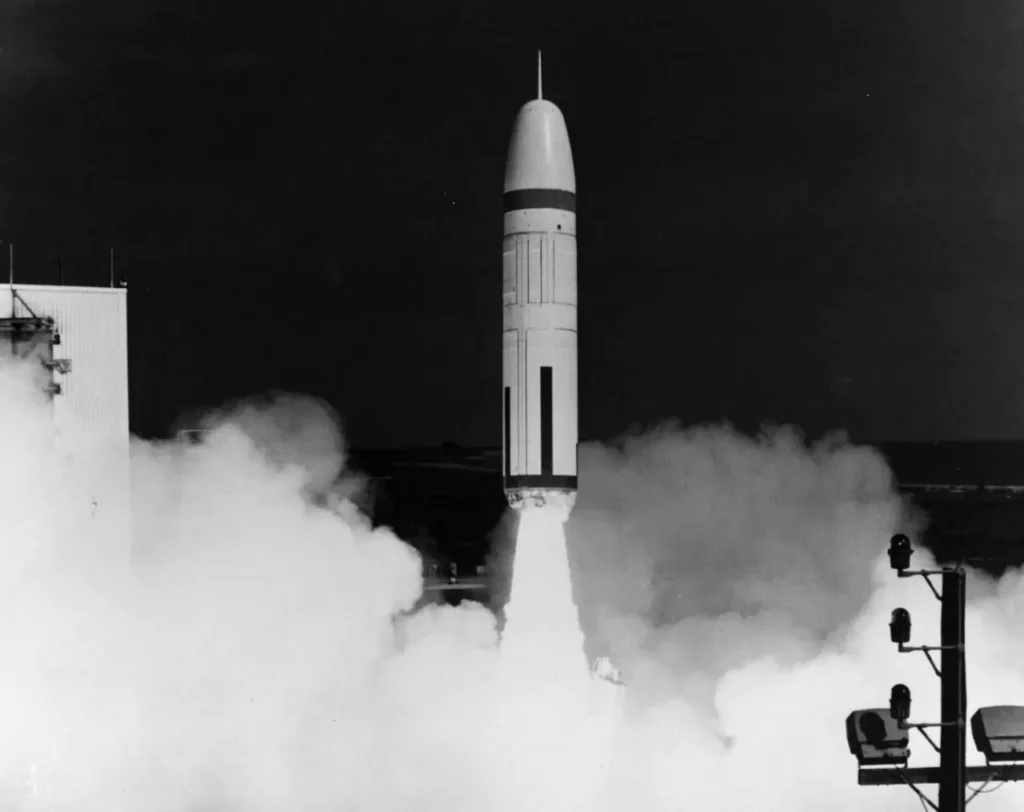
This sensor, activated during the post-boost flight phase, played a pivotal role in allowing Trident to achieve the precision of Poseidon over extended ranges. The post-boost vehicle following the missile’s third-stage separation utilized stellar data for making trajectory adjustments, and then efficiently dispensing the individual warheads.
Propulsion
As previously mentioned, the Trident I C-4 missile was a three-stage solid propellant design. In a departure from the Poseidon missile, which adopted more of a “clear deck” approach, the C-4 introduced a third-stage solid booster strategically located in the center of its movable equipment section. The main contractor for these motor stages was a joint venture of Hercules and Morton-Thiokol
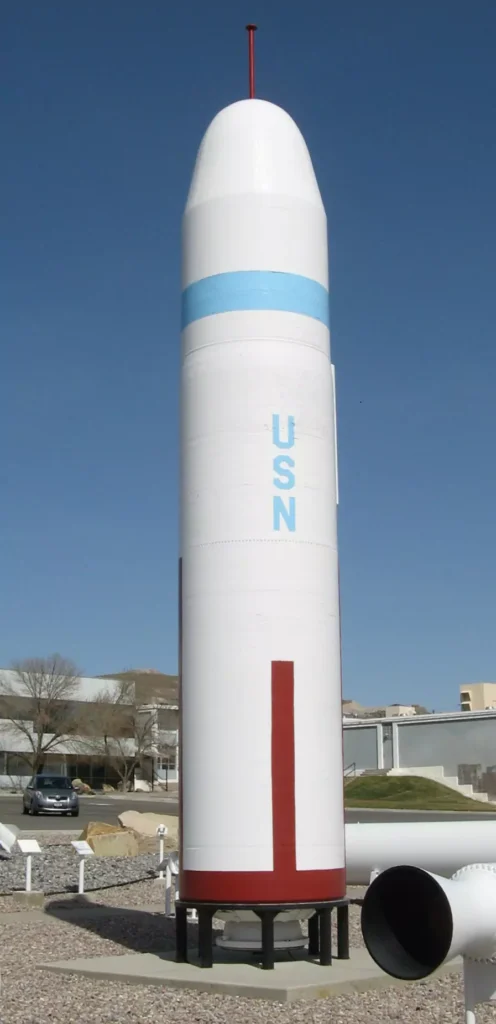
Notably, the propellant chosen for these stages was a cross-linked double-base (XLDB)-70, containing 70% solids. This was a significant upgrade, delivering more energy per volume than the propellant found in Poseidon.
To accommodate the demands of this propellant, the motor cases were constructed using high-strength Kevlar composites. This change ensured they could withstand higher internal pressures without adding extra weight. Furthermore, the nozzle throat sections were crafted from pyrolytic graphite, a choice that combined lightweight properties with the ability to endure elevated temperatures.
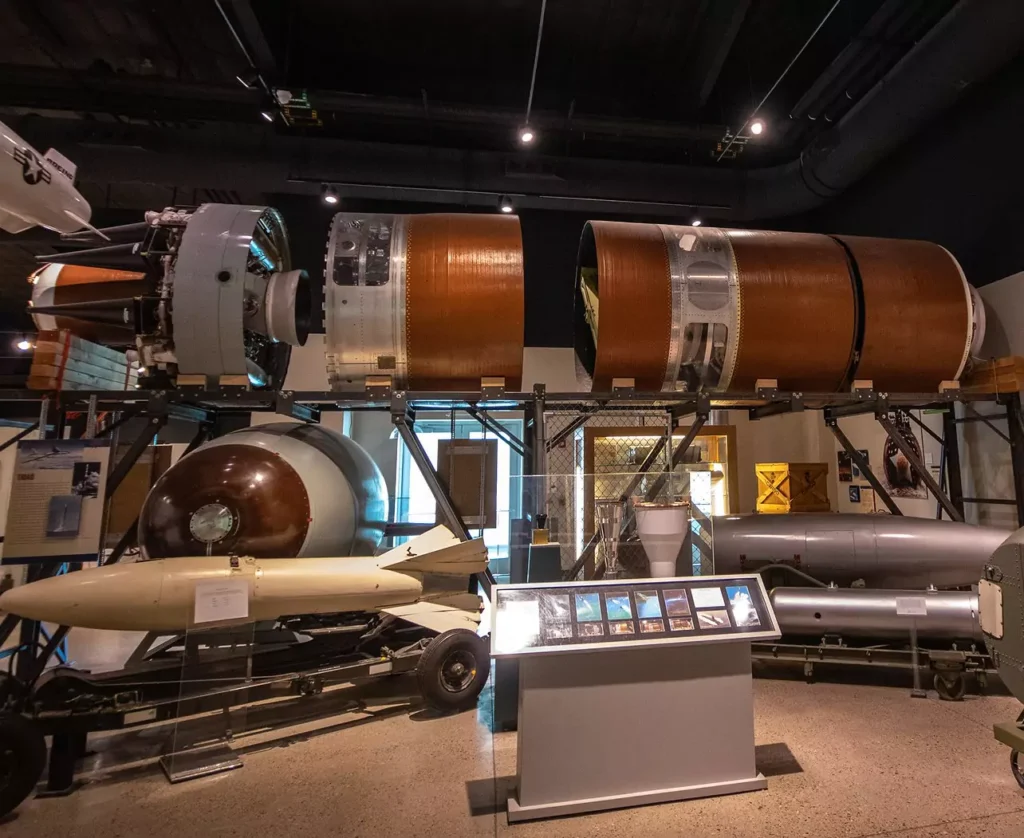
Each stage had a unique movable nozzle. This nozzle operated under a thrust vector control system, which had been redesigned to be more lightweight than its predecessors, relying on gas hydraulics for operation.
A new feature of the C-4 was its trajectory management. Rather than stopping thrust early, the missile utilized its full energy to shape its path, a method aptly termed “generalized energy management steering.”
The C4 could be launched both above and below water. Once the missile got a push from a gas generator out of its launch tube, the first stage fired up as soon as it was out in the open.
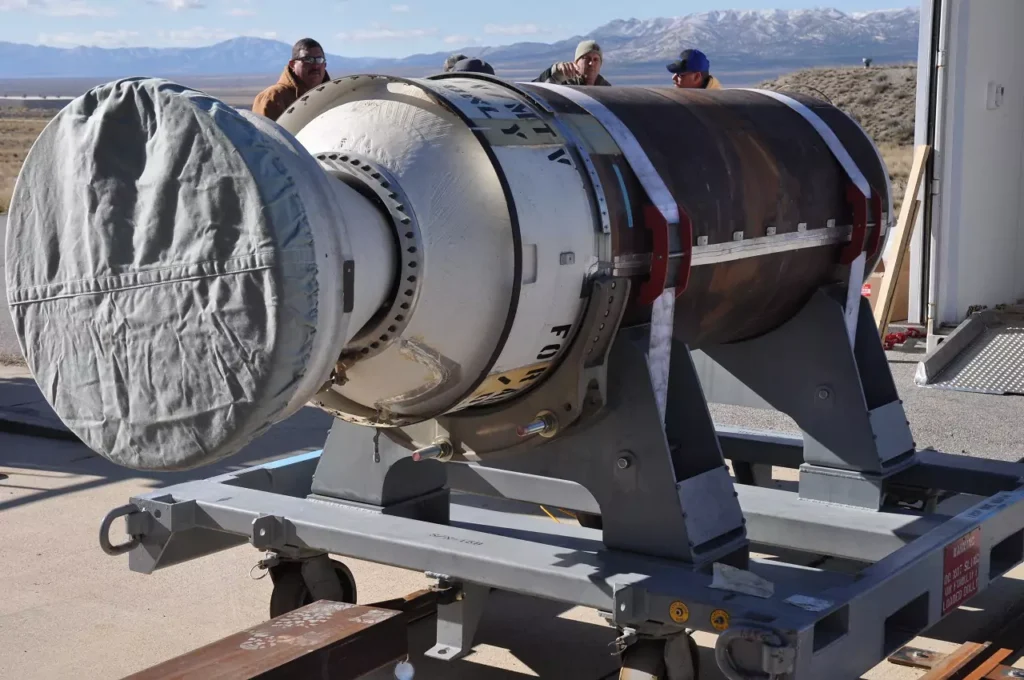
Older Poseidon boats used the Mk 88 Mod 2 to control these missiles, while Ohio-class subs had the Mk 98. The latter was an upgraded version of Poseidon’s Mk 88 but with added computing power. In fact, its onboard computer could store up to 2 million words, ensuring it was always ready for action.
Payload & Warheads
Equipped with MIRV warheads, the C-4 missile utilized eight Mk 4 reentry vehicles with a W-76 100 Kt thermonuclear warhead. When compared to its predecessor, the Poseidon C-3, the C-4 displayed double the yield and precision.
The reentry vehicles were located around the third-stage rocket motor as in the picture:
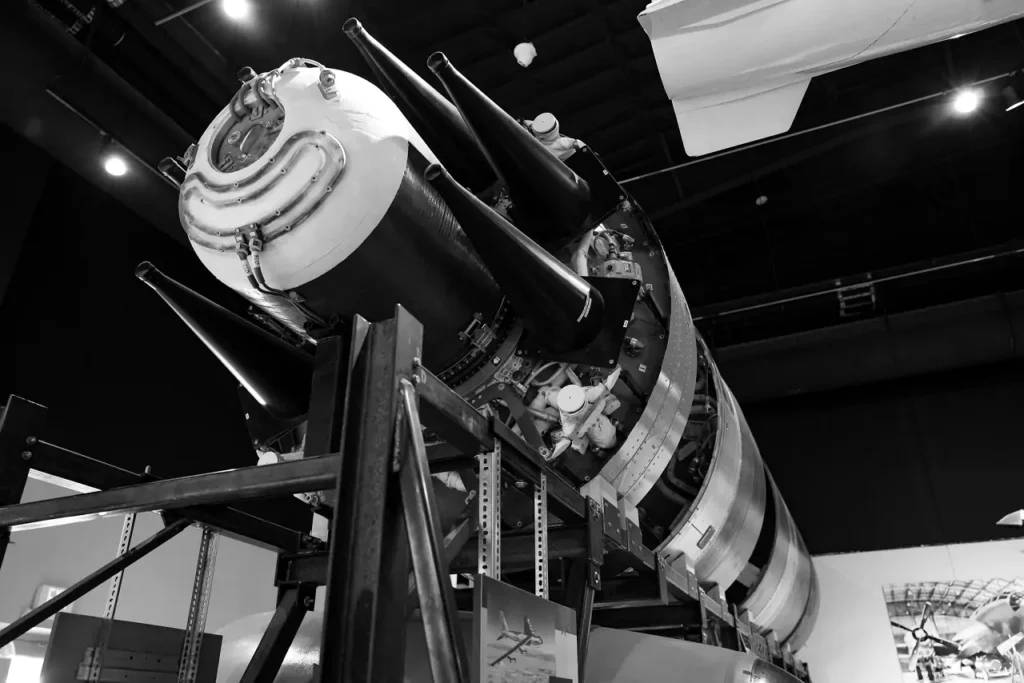
While the missile had the potential to be armed with the Mk 500 Evader MaRV warhead, designed to counter missile defenses, it never saw development. This MaRV development was eventually halted.
The missile’s throw weight surpassed 3,000 pounds, and its maximum range varied between 4,000 nautical miles when equipped with eight RVs, to 6,500 nautical miles with four.
Development
Origins and Early Development
In the late 1960s, the Department of Defense initiated the STRAT-X study, envisioning an advanced SLBM with a range of 6,000 nautical miles to be incorporated into a new class of submarines. From this vision emerged a two-phase program.
Firstly, the Trident C-4, inspired by the EXPO missile, was proposed with a range of roughly 4,000 nautical miles. Later, the longer-range Trident D-5 was slated for development.
By the mid-60s, the Poseidon’s development had commenced, aiming to amplify the launching submarines’ survivability by allowing an added 1,000 nautical miles standoff from targets. However, this ambition hit a snag; the Poseidon might not even match the range of the Polaris A-3.
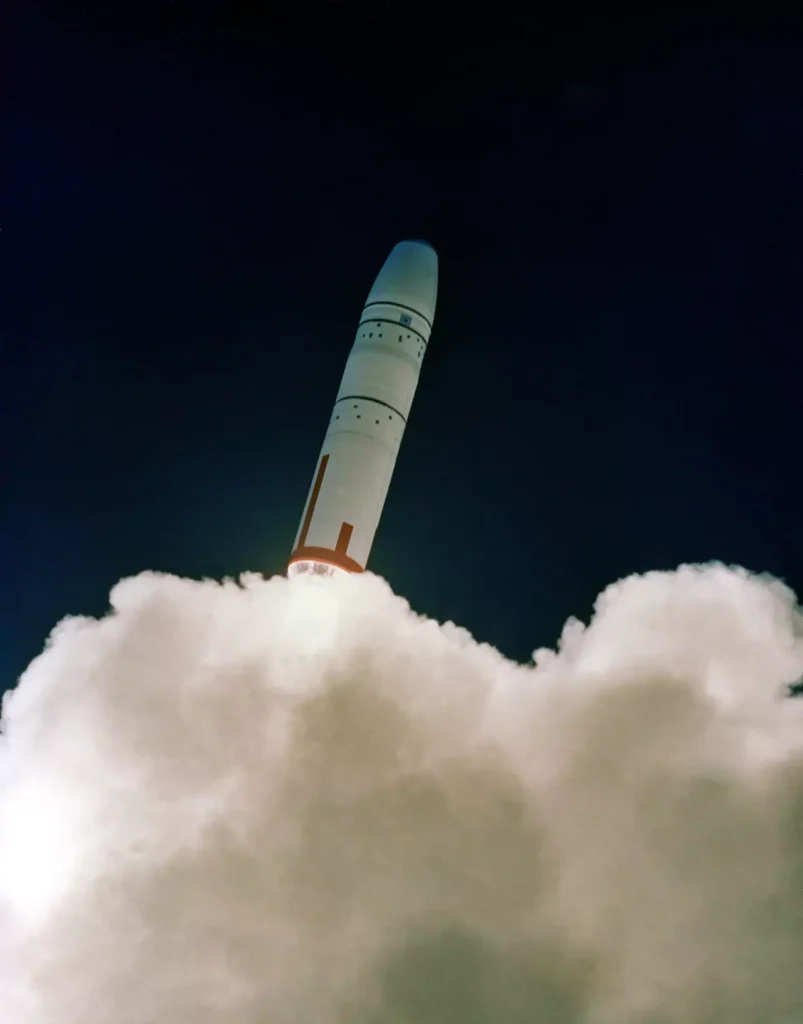
From UMLS to Trident I
In response, a research initiative was set in motion to determine the feasibility of a longer-range missile compatible with the Lafayette class submarines’ existing missile tubes. This mission, originally dubbed Extended Range Poseidon (EXPO), evolved into the Undersea Long-range Missile System (ULMS) program by 1971.
Fast forward to September 1971, Secretary of Defense Melvin R. Laird stamped his approval on the ULMS-I, a sentiment echoed by President Nixon in January 1972. Subsequently, in May, the program’s pace was quickened, and it was rebranded as Trident I.
Engineering Challenges
Crafting the Trident I with enhanced range without tweaking its dimensions or lessening its payload presented a significant hurdle. Lockheed engineers tackled this by reconfiguring the payload section to accommodate a third stage and adopting high-density, high-energy solid fuel from the Patriot missile initiative.
This fuel choice boosted thrust, and to counterbalance the fuel’s added weight, traditional fiberglass motor casings were swapped with lighter Kevlar versions. To further optimize the missile’s range, a telescoping aerospike was included, minimizing aerodynamic drag.
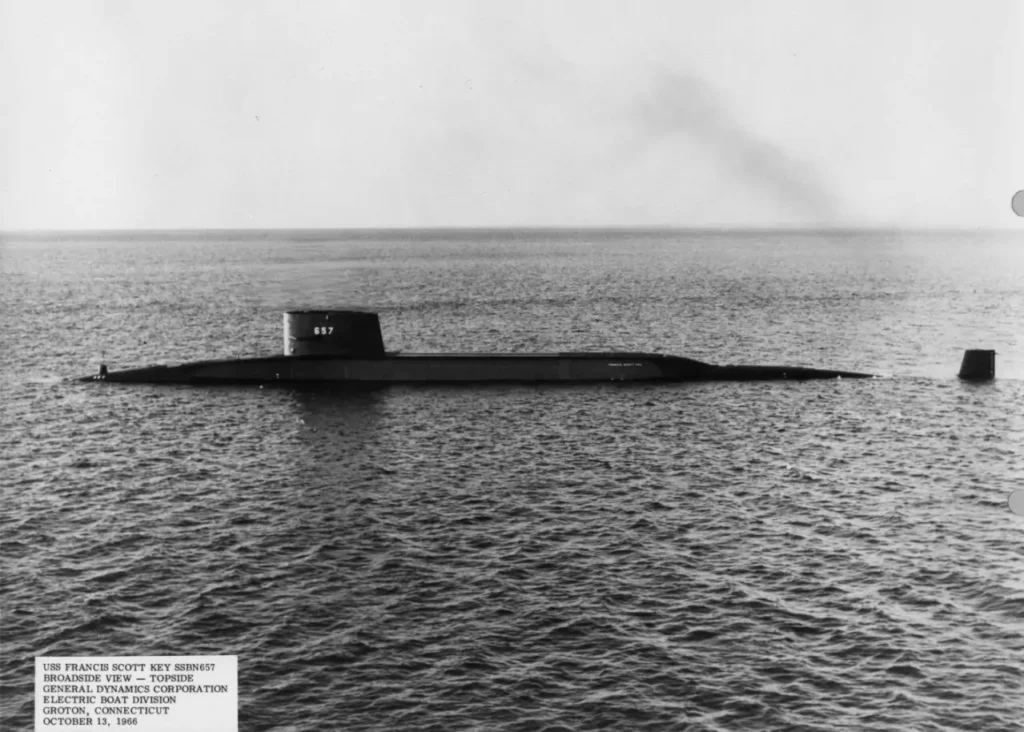
Testing
Integrating these innovations was time-intensive, with the inaugural test launch only occurring on 18 January 1977. Yet, what transpired was impressive. A staggering 10 out of the first 12 test flights were triumphant.
By January 1979, 18 successful flat pad launches had taken place. Focus then shifted to the submarine USS Francis Scott Key, which had completed its Trident transformation by 4 December 1978.
April 10, 1979, saw the first submerged Trident I launch, and by August’s end, seven Performance Evaluation Missiles had been launched, paving the way for the first DASO launch from the USS Francis Scott Key (SSBN-657).
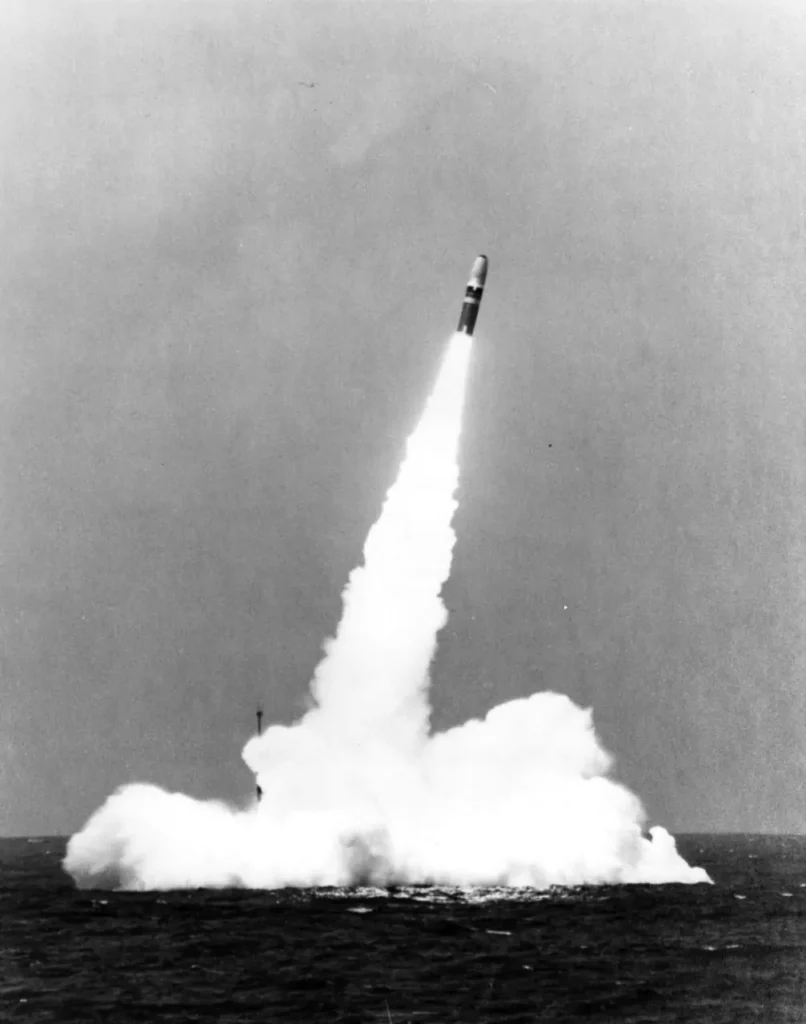
Trident II
In parallel, discussions at the highest echelons of the Nixon administration revolved around the development pathway for Poseidon’s successors. The final decision was to progress with a novel, larger Ohio-class SSBN slated for a 1978 deployment. This submarine would be equipped with either the Trident I C4, offering enhanced range and accuracy than the Poseidon, or the even more ambitious Trident II D5.
Why was the Trident C4 developed?
The decision to concurrently pursue the Trident I C4 and Trident II D5 in the early 1970s was driven by several factors. Firstly, while waiting for the Ohio-class SSBN to be ready, the smaller Trident I C4 could be retrofitted into the Poseidon-equipped submarine fleet. This choice brought three core advantages:
- Trident I C4’s extended range (4,000 nautical miles) expanded the submarine’s operational sphere, presenting a vast ocean expanse for Soviet anti-submarine efforts to cover.
- The enhanced range meant the submarine could quickly reach launch-ready positions and operate from safer zones, mirroring Soviet strategies with their longer-range SS-N-8. This especially included the SSBNs that needed to be relocated from Rota, Spain to the continental United States by the end of the 1970s.
- Equipping Poseidon-bearing submarines with the Trident C4 meant leveraging the C4’s unparalleled accuracy, a result of its star-guided RV and a potent 100-kiloton warhead.
Operative Service
Initial Deployment
In 1979, the UGM-96 Trident C-4 system became operational after 20 successful tests out of 23. Its introduction saw the USS Francis Scott Key (SSBN-657), a Benjamin Franklin-class submarine, go on its first Trident I patrol on October 20, 1979.
By August 1982, 12 Lafayette class subs, including the USS James Madison (SSBN-627), had been equipped with the Trident C4. September of that year marked the deployment of the first Ohio class submarine, the USS Ohio (SSBN-726), from Hood Canal’s Trident submarine base in Bangor, Washington.
As mentioned before, Trident’s deployment wasn’t primarily for enhanced capability, though it did elevate the Fleet Ballistic Missile force. The reason lay in political commitments. The U.S. had promised Spain that it would conclude its FBM operations in Rota by 1979. By equipping subs with Trident I, the U.S. could relocate them from Rota to Kings Bay, Georgia. If they had kept Poseidon missiles, these submarines would need an additional two-day voyage eastwards before the Soviet Union targets fell within range.
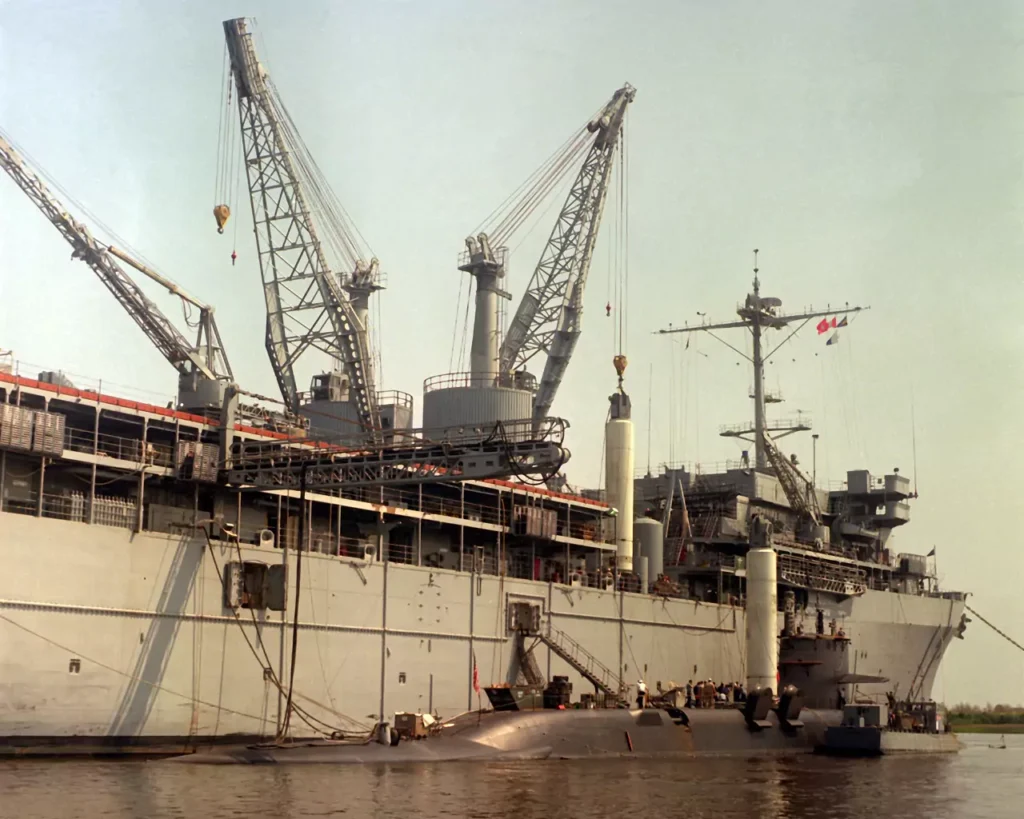
Fast forward to 1985, the share of the U.S. sea-based strategic deterrent was split between 304 Poseidon (C-3) and 312 Trident I (C-4) missiles aboard Poseidon submarines. Swapping C-3s for C-4s offered greater range, redefining submarines’ operating domains and boosting their survivability.
By 1987, eight Ohio class subs (SSBN 726-733), each equipped with 24 missile launch tubes, were operational, while the Trident C-4 was loaded onto 12 former Poseidon submarines (Benjamin Franklin and James Madison classes), with each submarine holding 16 launch tubes.
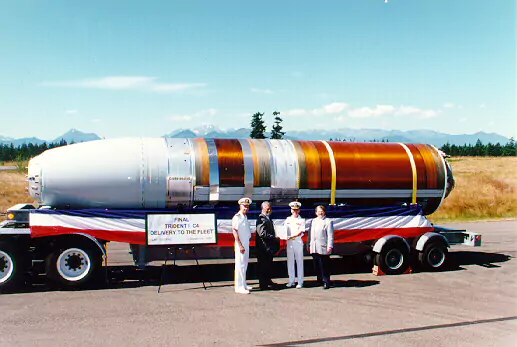
By January 1986, the Navy had received its final Trident I, arming in total 12 Lafayette class and eight Ohio class submarines. Around 385 of these missiles were active in 1991, out of the 570 produced between 1976 and 1986.
1990s
Post the SLBM limits set by START 1 and 2, there was a reorganization, and submarines from the ‘Benjamin Franklin’, ‘Lafayette’, and ‘Madison’ classes were decommissioned. Therefore, by 1996 only the eight Ohio class submarines remained, housing a combined 192 operational missiles, all stationed in Washington state for the Pacific Fleet.
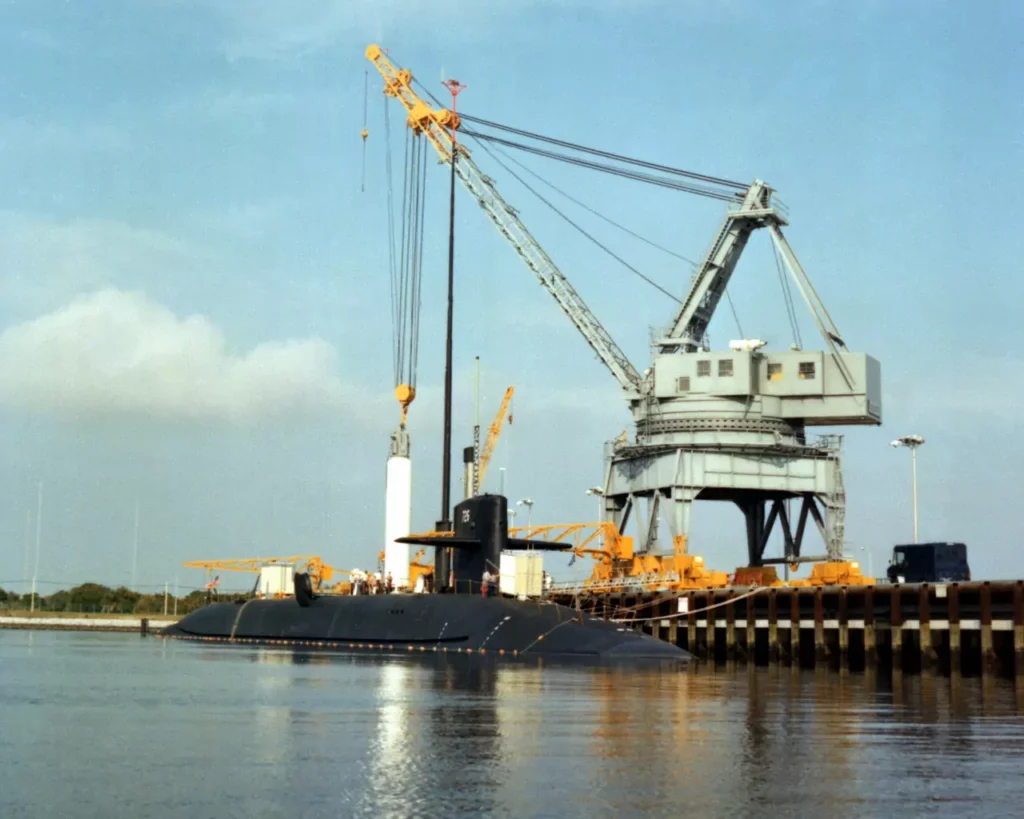
The nuclear-powered strategic missile submarine USS Ohio (SSBN-726) is loaded with a C-4 Trident I missile. (National Archives)
A change came in 1998 when the U.S. Navy announced that four Ohio class submarines would be adapted to carry the larger Trident D-5 missiles. By 2001, the plan was for the remaining four to be equipped to hold up to 154 UGM-109 Tomahawk cruise missiles and accommodate special operations personnel, including SEALs.
2000s
From 2002 to 2007, the first four Trident submarines (SSBN 726-729) underwent a transformation to a non-nuclear role. Concurrently, the remaining four Ohio class submarines (SSBN 730-733) with C-4 capabilities saw conversion to the D-5 missile between 2000 and 2005.
Lastly, December 15, 2003, marked the last milestone, with the USS Michigan (SSBN-727) completing the Trident I C-4’s final successful patrol.
Though the missiles were initially slated for a ten-year service life, this duration was stretched to two decades. Up until December 2001, 225 test launches for C-4 missiles had been conducted, with an annual average of five or six missiles and several more fired in groups of two to four.
For numbers and figures about the Trident D4 deployment, explore our dedicated article on the Trident I C-4 Missile Deployment (1979-2004).
The UK Trident Program
In the late 1970s, the UK, foreseeing the end of the operational lives of their Polaris SSBNs by the mid-1990s, sought a robust replacement. Therefore, in July 1980, the British Government chose the U.S. Navy Trident system, specifically the Trident C4 as the successor.
However, in 1982, the UK shifted preference to the Trident D5 missile after President Ronald Reagan’s announcement to replace the Trident C4 with the D5 system. This culminated in the signing in March 1982 of the Trident D5 agreement between the UK and US mirroring the terms of the 1963 Polaris Sales Agreement.
More about Trident I (C4)
Further reading
- United States Submarine-Launched Ballistic Missiles (SLBM)
- Ohio-Class (SSBN-726) Ballistic Missile Submarines
- Poseidon C-3 (UGM-73)
- Trident II D-5 (UGM-133A)
Bibliography
- Nuclear Weapons of the United States: An Illustrated History by James N. Gibson, 1997
- The U.S. Nuclear Arsenal: A History of Weapons and Delivery Systems since 1945 by Norman Polmar Robert & S. Norris, 2009
- Jane’s Strategic Weapons Systems, Issue 38, Jane’s Information Group, UK, 2003
- The Fleet Ballistic Missile System: Polaris to Trident by R. A. Fuhrman, 1978